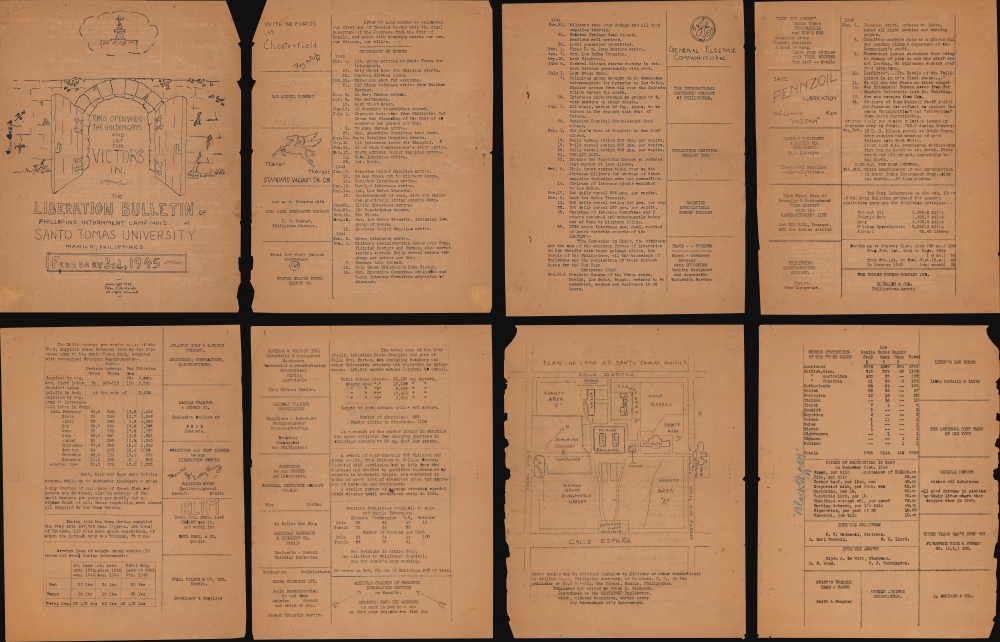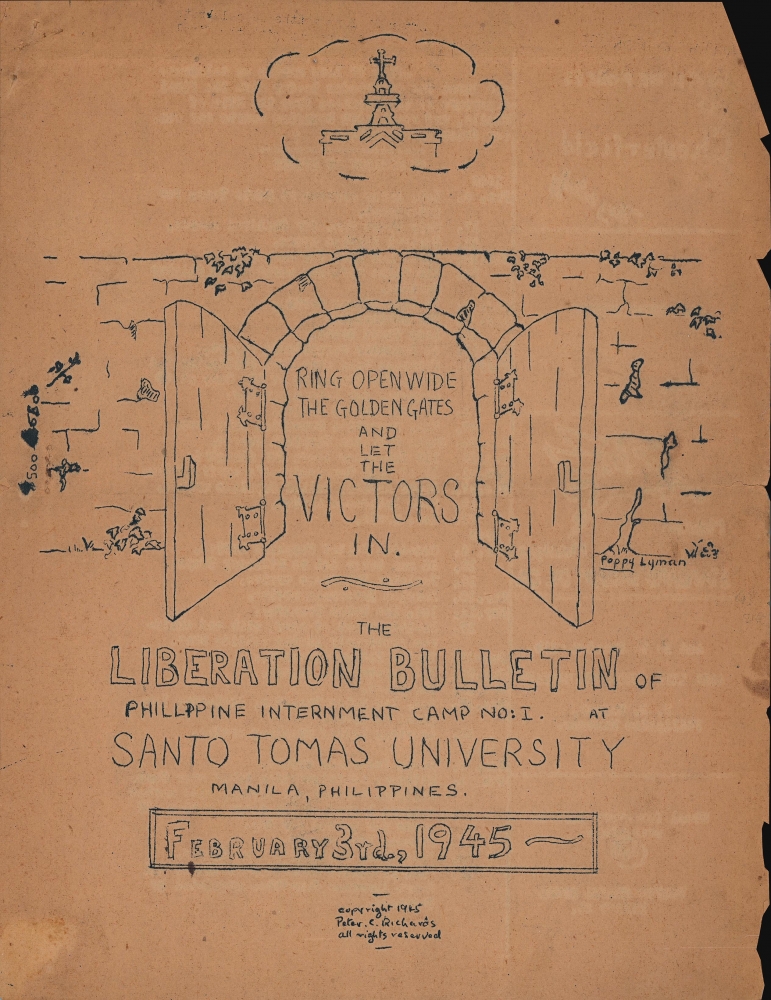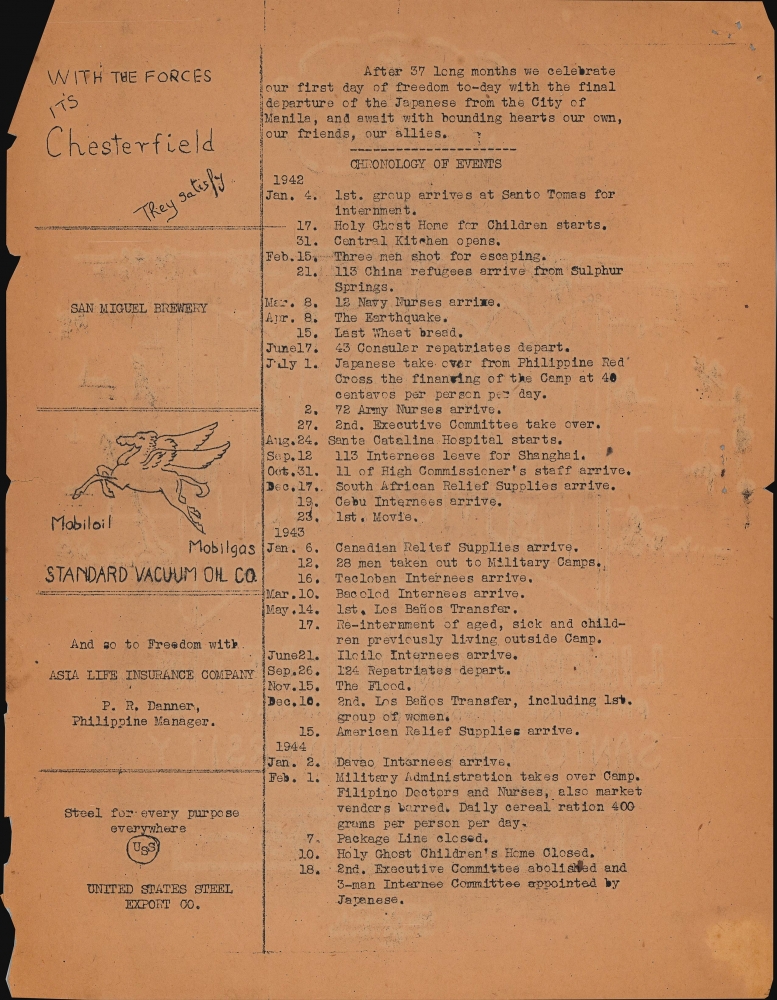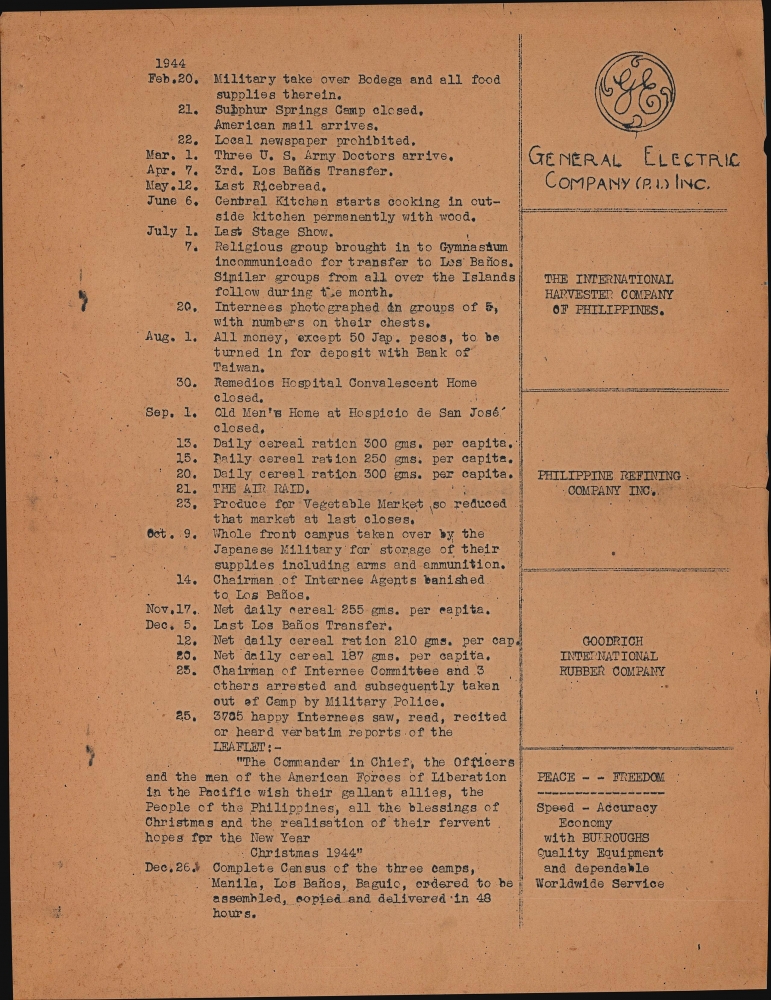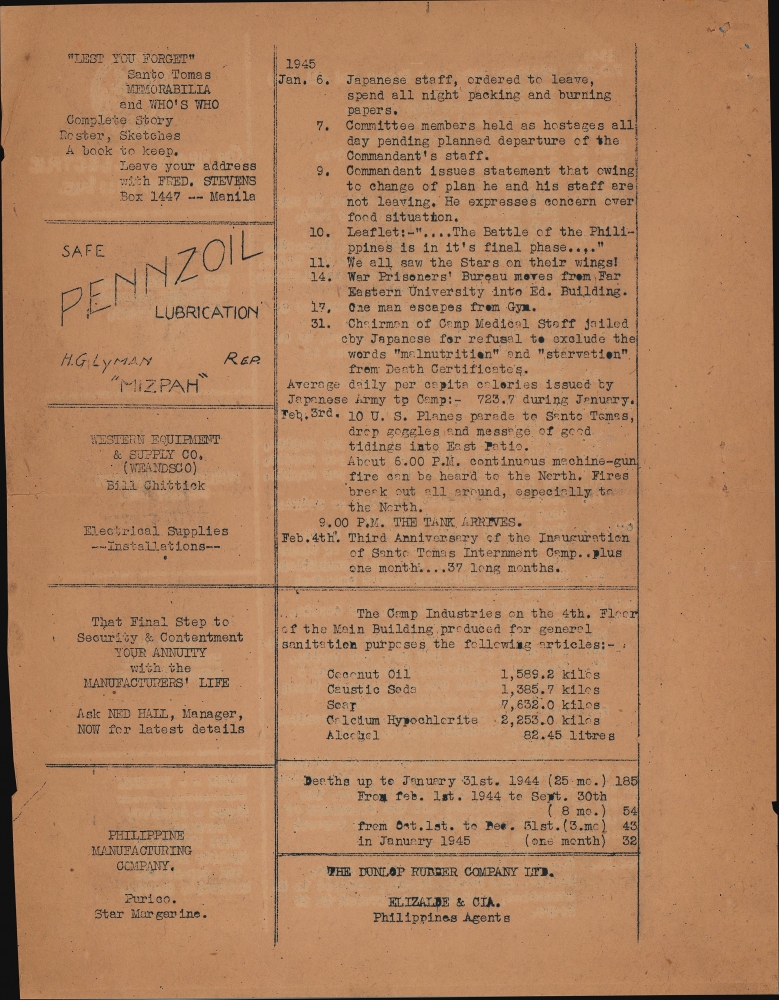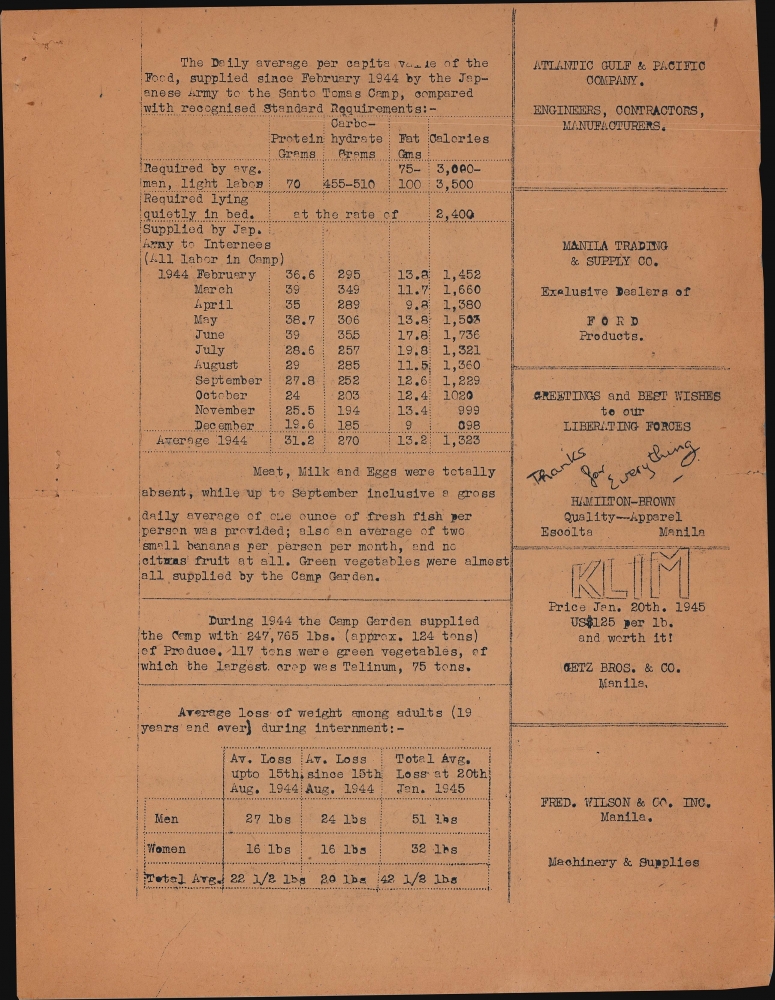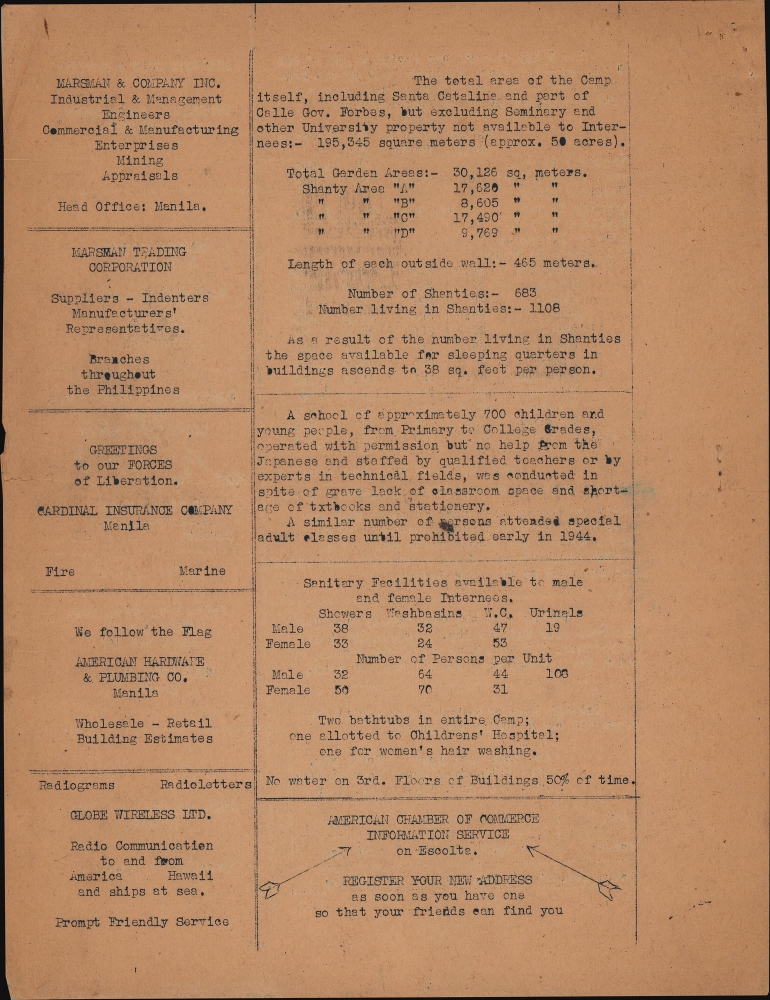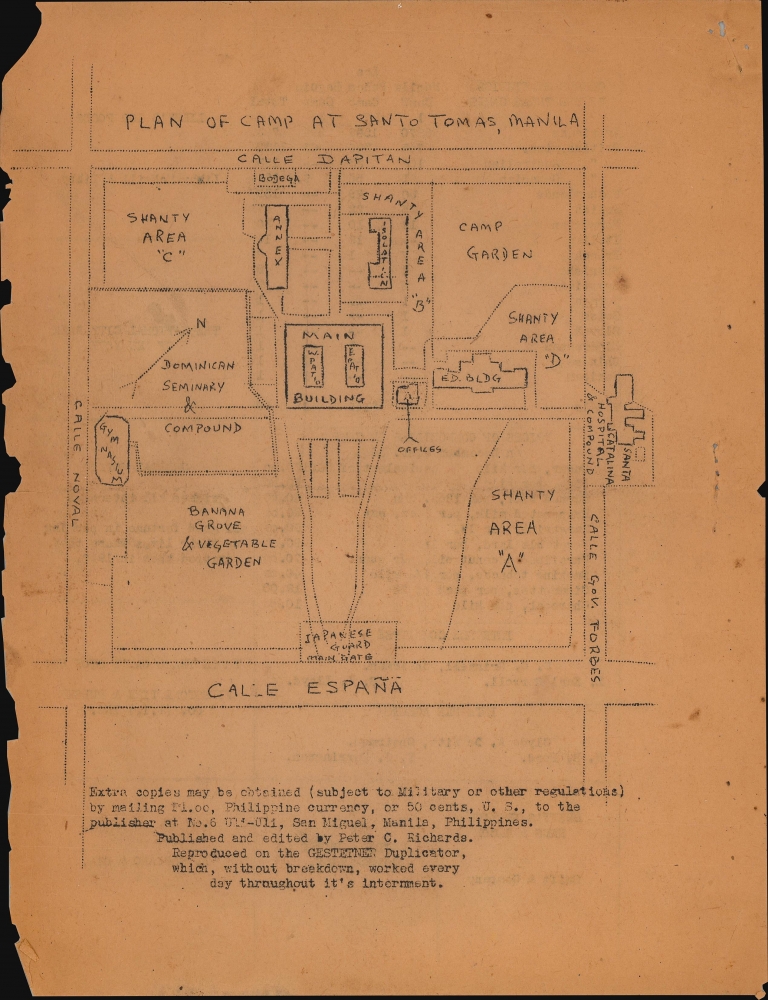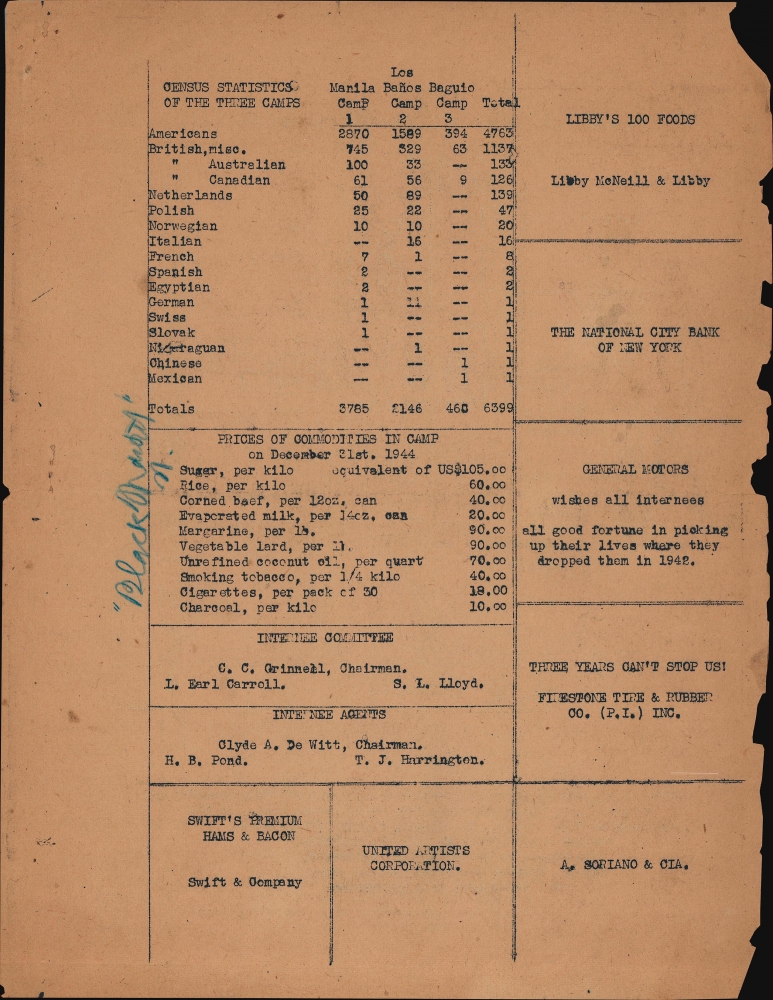This item has been sold, but you can get on the Waitlist to be notified if another example becomes available, or purchase a digital scan.
1945 Richards 'Liberation Bulletin' of Santo Tomas Internment Camp, Philippines
SantoTomasLiberationBulletin-richards-1945
Title
1945 (dated) 11 x 8.5 in (27.94 x 21.59 cm)
Description
A Closer Look
Consisting of four mimeographed sheets printed on both recto and verso, Richards's 'Liberation Bulletin' provides a summary of life in the Santo Tomás Internment Camp. The cover features an illustration of the camp's front gate thrown open, with the phrase 'Ring Open Wide the Golden Gates and Let the Victors In' appearing in the open doorway. The high stone wall looms ominously on either side. Below the title proclaims 'Liberation Bulletin'.A chronology of events within the camp occupies the next two-and-a-half pages, with the introduction, 'After 37 long months we celebrate our first day of freedom to-day with the final departure of the Japanese from the City of Manila, and await with bounding hearts our own, our friends, our allies'. An inventory of 'camp industries' follows the chronology, listing the amounts of coconut oil, caustic soda, soap, calcium hypochlorite, and alcohol produced. On a more somber note, a death toll of 314 follow these figures. Next follows a report of per capita food allowances from February through December 1944, along with reports on availability of food, the production of the camp garden, and average weight loss among interned adults.
On the following page, Richards chronicles the total area of the camp, including the shanties built by internees. This is followed by a note about the school operated within the camp for the 'children and young people', for which Richards created a Spanish Verbs. Then Richards details sanitary facilities within Santo Tomás.
The next page is occupied by a full page plan of the camp. Here Richards illustrates the camp's main building, the education building (which played an important role in the daily lives of the internees), the two camp gardens, and the four shanty areas. The 'bodega' where internees who had money bought food and other supplies, the isolation ward, and the Hospital Compound are marked as well. The Gymnasium, which is referenced in the chronology several times, is labeled. A note at the bottom states that additional copies of the bulletin could be purchased from Richards for one Philippine peso and provides his address, then states that it was 'reproduced on the Gestetner Duplicator which, without breakdown, worked every day throughout it's [sic] internment'. The last page details the nationalities of internees at Santo Tomás, Los Baños, and Beguio, and states that a total of 6,399 individuals were interned at the three camps.
Advertisements?
Perhaps the most unexpected aspect of the entire bulletin is that advertisements for American and Filipino businesses appear along the sides of six pages. Among the recognizable companies are G.E., Firestone Tire and Rubber, the Standard Vacuum Oil, and Pennzoil. We have been unable to find any comments by Richards or others concerning the advertisements. Perhaps, by including the advertisements, Richards underscored the fact that everyone in the camp was on the road back to a 'normal' life after their thirty-seven month ordeal.Santo Tomás Internment Camp
Established in January 1942, the Santo Tomás Internment Camp occupied the grounds of the University of Santo Tomás in Manila. The Japanese arrested thousands of 'enemy civilians' and interned them in the camp, including 3,200 Americans. Among the internees were 400 children. The internee population was diverse and included salesmen, waiters, business executives, prostitutes, missionaries, and many others. Internees were segregated by sex and the Japanese stringently controlled what they viewed as 'inappropriate' relations between the sexes among the internees, which meant any public display of affection, including handholding, or any other intimate contact, whether publicly viewable or not.For the first two years of confinement, the internees mostly governed themselves, with an executive committee liaising between the internees and the Japanese prison officials. For the first two years food was (relatively) accessible. However, as the war worsened for the Japanese, critical supplies became scarce or nonexistent for the internees and the Japanese abolished their self-governance. The last year of confinement was marked by worsening conditions, high rates of disease, and a much higher death toll. The camp was liberated by the American 44th Tank Battalion on the night of February 3, 1945, and the internees were repatriated over the ensuing months. During their thirty-seven months of confinement and the following month, from January 1942 through March 1945, 390 total deaths were recorded at Santo Tomás.
Publication History and Census
This bulletin was published by Peter C. Richards on February 3, 1945. News articles from 1945 state that 2,500 examples were printed and, in an address given by Peter C. Richards to the Makati Rotary Club on February 5, 1985, he confirmed that he and his wife used the duplicator machine at the Santo Tomás Internment Camp to print the bulletins. Those same news accounts from 1945 state that the bulletin was sold for one peso each. We note three examples cataloged in OCLC: Wisconsin Veterans Museum Research Center, San Diego State University, and Stanford University. A fourth cataloged but incomplete example is part of the collection at Western Carolina University (it is lacking the final page bearing the plan of the internment camp, census statistics, and commodity prices). We are aware of three other examples (including the presently-offered example) in private hands, bringing the total to seven known surviving examples.Cartographer
Peter Clifton Richards (September 25, 1909 - 1992) was a British salesman and news correspondent as well as a civilian internee at the Santo Tomás Internment Camp in Mania. Born in Streatham, Surrey, his father served in the HM Consular Service, with postings to Grand-Bassam, Ivory Coast, as Vice-Consul (where he was posted when Richards was born), Consul and Deputy Commissioner for the South Pacific, Consul at Callao, Peru, and Consul-General in Chicago. Richards' parents sent him to Sherborne Preparatory School in 1919 and he attended Sherborne School from September 1923 until July 1927. After graduating from Sherborne, Richards started working for the Anglo-South American Bank. He worked for the bank until 1935 when he became a salesman for D. Gestetner Ltd, which manufactured duplicating machines, and Gestetner sent him to Singapore and Manila to sell their machines. He met Dolores Opisso while working in Manila, whom he married. Richards was in the Philippines on December 7, 1941, when the Japanese attacked Pearl Harbor, Hawaii, pulling the United States into World War II. The Japanese attacked the Philippines (then an American Commonwealth) on December 8 and entered Manila on January 2, 1942. Both Peter and Dolly were interned at the Santo Tomás Internment Camp in Manila along with thousands of other 'enemy civilians'. While interned at Santo Tomás, Richards was in charge of using the camp's Gestetner machine to reproduce camp orders, regulations, and forms, all under the watchful eye of the Commandant, thus ensuring that Richards did not print any anti-Japanese propaganda. Surprisingly, the Japanese allowed Richards to print some other documents on the machine, including a beginning Spanish booklet to teach children in the camp Spanish, and the occasional camp newsletter. It was with this Gestetner machine that Richards printed his eight-page 'Liberation Bulletin' on the day of the camp's liberation, February 3, 1945. After liberation, Peter and Dolly left Manila on April 14, 1945, and arrived on May 25, 1945, in Liverpool. Richards joined the Reuters News Agency in August 1945 and he and Dolly left for Manila in July 1947 where he was Reuter's Manila Correspondent. More by this mapmaker...

